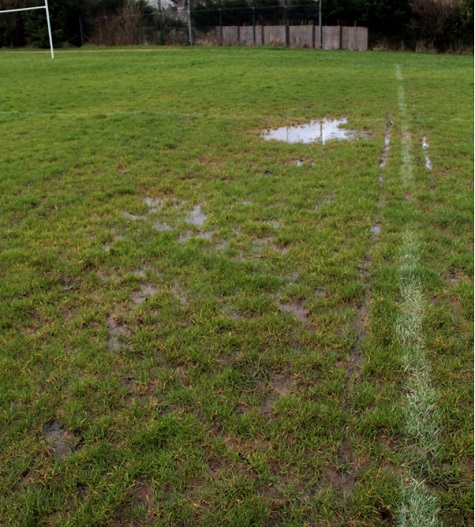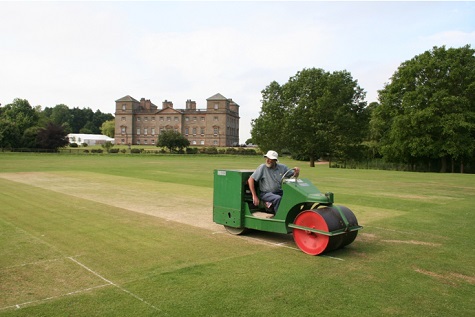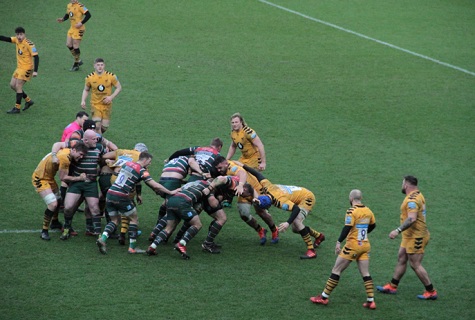The title of today's blog is a well-known folklore saying that is no doubt on many people’s minds at present - especially those in vulnerable flood areas.
The counties of Worcester, Herefordshire and Shropshire have particularly borne the brunt of the recent severe weather, with the rivers, Severn and Wye flooding large tracts of land and causing millions of pounds worth of damage.
I found some interesting rainfall stats on the Headland Amenity website.

For several years Mark Hunt, technical manager for Headland Amenity has been writing a valuable weather blog for grounds professionals that is well worth a look at.
The above graph shows that to date, we have received double last year’s rainfall total for February in Wales (161.55 mm). This coupled with the downpours we had last year, makes this one of the wettest winters for over 20 years.
This has also been borne out by the number of matches that have been called off due to the weather. The two recent storms, Storm Ciara and Storm Dennis have caused deaths, structural damage, travel disruptions and severe flooding across the country over the course of two successive weekends.
It is certainly going to be testing time for many of our practising groundsmen and women, especially with more rain forecast. Most, if not all, soil based pitches will be struggling to cope with this amount of rainfall. The best solution is to keep off until the surface water disappears and the top begins to dry off.
Playing on saturated pitches will only end in tears, with a lot of surface damage and loss of grass cover. Even pitches with installed drainage systems are now struggling to cope with the shear amount of rainfall.
Last week, I inspected two Midlands rugby clubs, Bredon Star and Bromsgrove RFC, on behalf of the RFU to look at some drainage issues. Both clubs have pitches that ideally need to be drained to improve their playability during the winter months. Bredon Star RFC have not been able to play on their pitches since November!

There is no doubt that there will many sports clubs who will be counting the cost of lost fixtures and seeking help to repair, renovate and indeed install drainage schemes to improve the condition of their playing facilities after this testing year of poor winter weather.
For many clubs, the problem often lies in the fact that they are not investing enough time and money in the general maintenance and end of season renovations of their pitches. Many clubs can tend to do the bare minimum, which often relates to mowing and marking out, with little other work being done unless it has become a problem.

These pitches are the life blood of the clubs and more thought and commitment should be channeled to increase the expenditure for grounds maintenance. Yes, there is a cost attributed to maintaining pitches properly, but it’s value for money in the long term.
This attitude of the grounds budget having the lowest priority seems to be common amongst too many sports clubs - including cricket, bowls, football and rugby. Having myself, like most sportsmen, been brought up within the club system, starting as a junior, going on to represent your county and play for more senior clubs, this journey would not have happened without the national club structure we have in the UK.
So how do we put a price on the value of these community clubs and what they provide for many hundreds of thousands of people every weekend? To quibble about the cost of maintaining these vital assets is a crying shame.
I am fully aware of the constraints and costs of running these clubs, with so much to pay for in terms of staff wages, utility bills, coaches, players, machinery, building maintenance and any loans they may have.
One of the main problems, is the fact that clubs are not charging enough for memberships. An average fee can be anything between £50-£150, with youth membership half or three quarters the cost.
However, taking that as a norm a club of 200 plus members paying around £100 per member will only generate around £20,000 pounds. This can be compounded by the fact that many players get out of paying anything or indeed want paying for playing!
Whist on the subject of paying players, in the long term is it really a good policy for the clubs? Would that money be better spent on improving the facility? I have seen, over the years, many clubs going down this route, often via a rich benefactor. This often comes to an end when the individual decides to leave the club, leaving them in a perilous position. The question we must ask, is at what league level should players be paid?
Running a sports club requires a lot of effort and commitment from members. Most clubs have keen ex playing members who take up volunteer roles within the club. However, the larger clubs will have several paid professionals, coaches and bar and facility staff that need paying.
Therefore, most clubs need to rely on other ways to raise much needed funds – for example, bar takings, functions, events and sponsorship. However, the success of these is purely down to the club’s committee being well run and having a good social side to the club.
I would not be surprised to find that most small-sized clubs probably need to raise in excess of £120,000 plus annually to function, taking into account all the overheads they now have.
Based on using professional contractors who are carrying out a fairly intense maintenance programme that consists of regular mowing, feeding, marking out, aeration weed killing and end of season renovations that encompasses scarification of the pitch in two ways, vertidraining, topdressing 60 tonnes of sand, overseeding and fertilising - I would see that work costing around £12,000 per pitch.

However, in reality most clubs are only getting their pitches mown and marked out - with perhaps one application of selective weed killer and fertiliser. Based on contractors’ prices, 30 cuts and a weekly pitch marking coupled with some other works, will cost around £2500-3000 per pitch.
At the end of the day there is a cost for maintaining natural grass pitches. Even if you get free labour, (club volunteers) the club will still need to invest in machinery and materials.
My point is, how do we value these clubs, in what they provide for the community? There are literally hundreds of thousands of kids and adults benefiting from the running of these facilities.
If you and I want to join a fitness gym, in most cases they will be charging over £500 pounds to join. So, is it about time we start investing in our own beloved sports clubs and ensure they are here for the next generation of potential sporting stars?

Grass root sports clubs are essential assets in every village and town. If we do not support them and, more importantly, pay enough membership fees to help them maintain these facilities, then before long we will see a demise and death of many clubs.
I firmly believe that sporting governing bodies could do more to help support these grass root clubs. However, attention seems to be focussed on higher ranking sports clubs. It is the village and town clubs that need more help and assistance in managing their facilities.
Working with potential industry partners, there is no reason why clubs cannot be helped in getting the right funding and support to deliver a fit-for-purpose playing facility. Thanks to the lottery we have seen many clubs prosper from this investment, where capitol monies have been used to build new pitches, provide floodlights, install artificial pitches and install drainage schemes.
However, there has never been a pot of money for maintenance. Maybe there should be a proportion of the capital funding set aside for initial maintenance to ensure the facility is functional for at least three years after installation? This would allow the club time to find the additional funding for this new facility.
As mentioned in a recent blog, Spring Has Sprung, now is the time to start planning and getting your end of season work quotations ready. Securing the services of a contractor may be difficult this year. There is going to be a high demand for their services after such a tough winter.

To finish, I would like to take the opportunity to thank Simon Hewitt (head of marketing at STIHL) for inviting me and my wife along to see Leicester Tigers play Wasps at Welford Road recently. I, along with several other media influencers, were very well looked after during the day. We had a tour of the stadium, changing rooms and pitch, and enjoyed some pre-match entertainment with guest speakers that included Tigers players and Ian Robertson international match commentator.

Having played against the Tigers myself in 1980, some 40 years ago, it was nice to see behind the scenes and see how things may have changed. In fact the changing rooms, although moved to a different stand, they were just like the ones we used all those years ago. They are not large by any means. We also had the chance to Speak to ED Mowe, the club’s head groundsman, who in three years has turned the pitches around. And testament to his work, the pitch looked and played perfectly during Storm Dennis.

So, to end such a stormy week, I would like to you all to think about those unsung heroes (groundstaff) who up and down the country are endeavouring to keep pitches playable during this challenging winter period. Hopefully clubs will start to see the benefit of investing more money for the maintenance and upkeep of their valuable pitches.